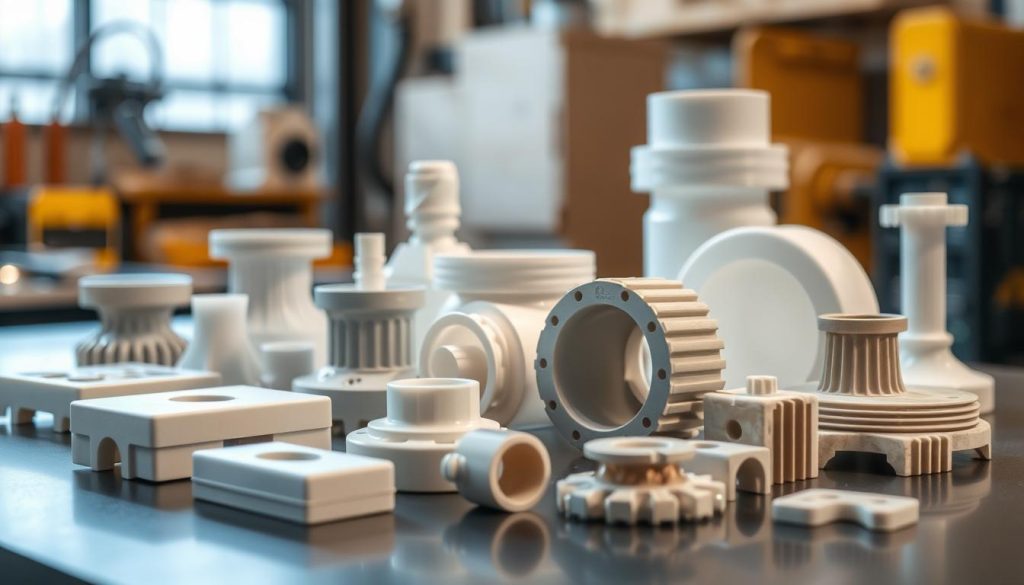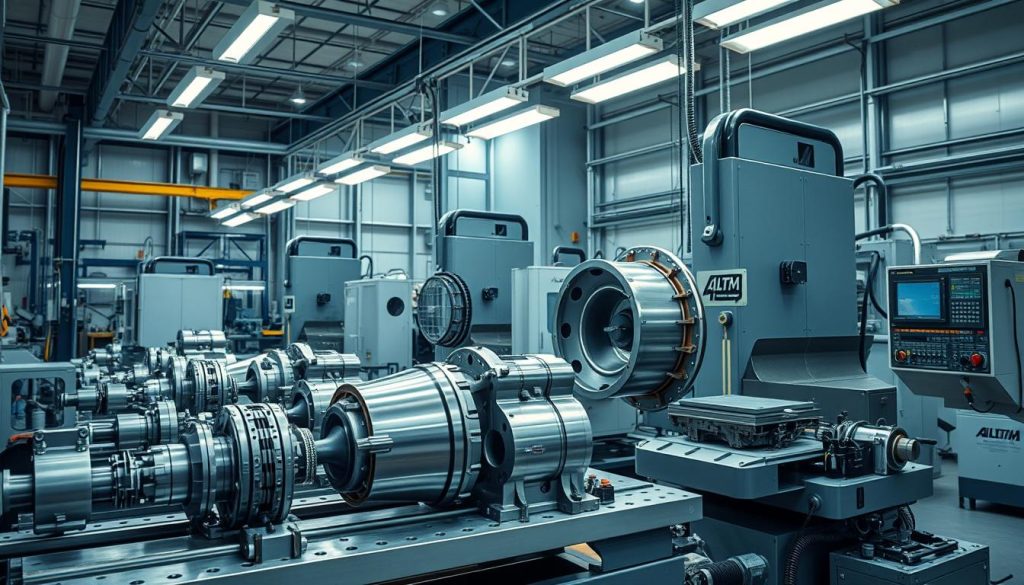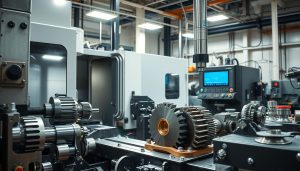
Ultimate CNC Machining Guide for Experts & Beginners
The world of CNC machining, or Computerized Numerical Control Machining, is both vast and intriguing. This guide serves everyone, from beginners to experts. It aims to deepen your understanding of CNC technology’s core ideas and higher-level applications. The global CNC machining market reached a value of USD 66.74 billion in 2023. This highlights its crucial role in today’s manufacturing. With a focus on precision, we delve into basic and more complex CNC machining techniques. These techniques help improve both efficiency and accuracy.
In today’s industry, producing complex shapes with high precision is possible thanks to CNC machining. It significantly boosts accuracy, speed, and the quality of the surface. This guide will discuss various CNC processes. These include laser cutting, CNC milling, CNC turning, and drilling. Each process is best suited for different tasks. Whether you’re starting or looking to refine your skills, this guide aims to provide the know-how needed to excel in precision manufacturing.
Key Takeaways
- The global CNC machining market was valued at USD 66.74 billion in 20231.
- CNC machining can produce complex shapes with tight tolerances enhancing accuracy and speed1.
- CNC processes include milling, turning, drilling, and laser cutting1.
- This guide offers beginner CNC guidelines and expert machining tips for all experience levels.
- Understanding the basics and advanced techniques will enhance efficiency and precision in CNC machining projects1.
Introduction to CNC Machining
Computer Numerical Control (CNC) machining uses computers for precision control over machines. It’s a key process in making components precisely. By learning CNC basics, we see how pre-programmed software guides machines like lathes and mills. This allows them to cut and shape materials with amazing accuracy.
What is CNC Machining?
CNC Machining turns computer commands into actions by machine tools. These tools do tasks such as cutting and shaping metals, plastics, and woods. Operators input exact details into computers to make sure every piece meets high standards. It aims to make part production more efficient, reducing errors in manual work. CNC machines combine many functions in one setup, making operations cheaper2.
Modern CNC lathes work with two axes, X and Z, creating complex designs quickly and precisely23. CNC milling machines have three axes for extreme accuracy, with new ones adding more for tougher jobs23. This has raised the production of various CNC-made items like aircraft parts and wooden decorations2.
Historical Perspective of CNC Machining
The CNC story began in the 1940s with the first numerical control machines. They changed from using analog and digital computers instead of manual controls2. In the 1950s, NC machining grew with large cabinets for controllers. Smaller, powerful computers later boosted CNC technology, leading to today’s methods3.
CNC’s growth didn’t stop, helped by software and computing advances through the late 20th century3. Now, continuous 5-axis machines push CNC to new heights, tackling complex shapes. This evolution expands CNC machining’s uses and capabilities3.
Key Components of CNC Machines
CNC machinery is all about its essential parts, each playing a big role in how well it works. For anyone looking to get the best out of their CNC machines, knowing these parts is key.
Control Unit
The control unit is the CNC machine’s brain. It turns digital commands into mechanical actions. This part reads G-code and M-code, making complex tasks possible with great precision. The machine’s control unit takes care of essential operations like starting and stopping tasks, controlling spindle speed, changing tools, and setting the feed rate4. Through the control panel, operators can put in the programming instructions, making sure the machine works accurately and efficiently4.
Motors and Drive Systems
CNC motors and drives are key for moving the machine along different axes. This ensures tasks are done precisely. These systems have parts like amplifier circuits, drive motors, and lead screws4. Feedback systems also play a big role. They check the tool’s movement and make sure the machine keeps performing well4. CNC machines work fast, which means more work gets done with less waiting time5.
Spindle
The spindle is central to CNC machines, holding and moving the cutting tools. Its performance affects the machining speed, finish quality, and overall success. This is really important in fields like car manufacturing, aerospace, and medical devices, where every small detail matters5. High spindle speeds are needed for tasks that demand high precision, like making engine parts, body panels in cars, or turbine blades for planes5.
In summary, knowing the main parts of CNC machines is crucial for making them work their best. Investing in good control units, motors, and spindles means your CNC machine will work efficiently and reliably, suited for many different tasks.
Types of CNC Machining Processes
CNC machining includes many specific processes tailored to meet different production needs. Knowing about these types showcases the flexibility and precision CNC technology offers.
CNC Milling
CNC milling uses rotary cutters to change a workpiece. This allows for tasks like slotting, threading, and rabbeting. CNC mills cost from $10,000 for home models to more than $200,000 for industrial ones6.
The cost to run a CNC mill ranges from $40 an hour for a 3-axis machine up to $200 for machines with more axes6. With diverse capabilities, these machines can tackle complex designs and produce parts with high precision efficiently.
CNC Turning
In CNC turning, the piece spins in a chuck while a cutting tool shapes it. It’s used for making symmetric parts like cylinders and disks. CNC lathes begin at about $15,000, charging around $40 per hour for operation6.
Thanks to its high efficiency and accuracy, CNC turning is the go-to for parts that need precise shapes.
CNC Drilling
CNC drilling is about making exact, clean holes. It’s crucial for sectors that demand precision and consistency. By using CNC drills, the process ensures top-notch finishes and strict adherence to measurements.
Its affordability and precision make CNC drilling essential in fields that value detail.
Laser Cutting
Laser cutting uses intense lasers to slice materials with utmost accuracy. It’s perfect for detailed patterns and complex shapes. The cost for a CNC laser cutter ranges from $5,000 to $300,0006.
The operational expense is near $20 per hour6. CNC laser cutters are widely used in the automotive, aerospace, and consumer electronics industries for their superior accuracy.
Comprehensive Guide to CNC Machining
CNC machining is a high-tech way to make parts used in industries like aerospace, cars, and medical devices. This guide will show you how to use CNC technology. You start by designing parts with CAD software. Then, turn these designs into a format for machines using CAM processes. Finally, you make the parts by running G-code on CNC machines.
Designing with CAD Software
The first step in making something with CNC is to design it using CAD software. CAD lets engineers draw detailed models of the part in 2D or 3D. They can check and improve these designs for better precision and function.
With CNC, you can make many parts that are all the same high quality, from many materials. These include plastics, metals, and composites7. CNC is great for making complex parts accurately and efficiently8.
Translating CAD to CAM
After finishing the CAD design, the next step is to change this model into a format machines can read using CAM software. This step is important because it makes the toolpaths and G-code needed for the machines. Having CAD and CAM work together makes sure the design becomes a real item smoothly.
This step is key to avoid mistakes and keep the making process accurate8. It also lets CNC machines use different tools and work from many angles at once. This makes making things faster and more efficient8.
Executing G-Code
The last part of the CNC process is running the G-code. This makes the CNC machine follow the instructions to make the final part just right. The G-code tells the machine every move it needs to make to create the part accurately.
G-code is the main language for CNC machines, though some use M-code too8. This step turns the design from a computer into something real, closing the gap between design and making7.
| Process Step | Details |
|---|---|
| Designing | Creating detailed 3D models using CAD design software |
| Translating | Generating toolpaths & G-code using CAM processing software |
| Executing | Running the G-code on CNC machines to create the part |
Advantages of CNC Machining
CNC machining is known for its high precision, with tolerances as tiny as 0.004 mm9. This accuracy ensures products match their exact designs, minimizing errors9. These machines can work non-stop, all day, every day, boosting productivity9.
These machines can hold up to 30 tools, allowing the creation of complex shapes9. This is essential in industries like automotive and aerospace. CNC machines also improve safety by automating cutting and being enclosed910.
CNC machining is also great at saving materials. It cuts precisely, reducing waste and damaged parts10. This accuracy means higher quality, cost savings, and less energy use—about one-seventh of traditional methods910.
Switching to CNC machining means quicker production than old techniques10. This leads to cost savings and more productivity. CNC-made parts fit together easily, which saves assembly time and costs10.
Maintenance for CNC machines is quite simple, needing only tool changes and light cleaning9. They can work with many materials, making them versatile across various industries9.
Material Selection for CNC Machining
When you pick the right CNC materials, you get the results you want. We’re going to look at metals, plastics, and composites used in CNC machining. Each type fits different needs and performance goals.
Metal Options
In CNC metal machining, aluminum, steel, and stainless steel are top choices. Aluminum alloys are light but strong, with a specific weight making them perfect for many projects11. Mild steel is easy to machine and weld, known for its consistent weight11. Stainless steel, like the 304 and 316 varieties, is strong and doesn’t rust easily, marked by its particular weight range11.
| Material | Density (g/cm3) | Properties | Common Applications |
|---|---|---|---|
| Aluminum Alloys | 2.65-2.80 | Lightweight, Strong | Automotive, Aerospace |
| Mild Steel | 7.8-7.9 | Machinable, Weldable | General Engineering |
| Stainless Steel (304, 316) | 7.7-8.0 | Strength, Corrosion Resistance | Food Industry, Medical Devices |
Plastic Materials
CNC plastics are known for being flexible, durable, and affordable. Plastics like ABS, nylon, and PVC are often used. Each type is suited for specific uses based on its features. PVC, for example, is chosen for its ability to resist chemicals and moisture, even though its strength dips at high temperatures12. The CNC process requires knowing the operating temperatures to keep the materials strong12.

Composites
For composite machining, materials such as carbon fiber are chosen for their high strength yet light weight. These materials are perfect for niche areas like aerospace and sports, despite their higher cost12. It’s crucial to consider how these materials handle stress to avoid damage, ensuring a reliable final product12. Also, the cost and the precision needed for your project are important when picking materials. Tighter tolerances tend to raise the price12.
In summary, choosing CNC materials requires weighing cost, function, and the intended use. Understanding the special characteristics of metals, plastics, and composites helps in making the best choice for your CNC project.
CNC Machining and Modern Manufacturing Trends
The growth of CNC machining is deeply linked with the latest in manufacturing. Industry 4.0 mixes digital tech and artificial intelligence into making things. This smart manufacturing era is changing how CNC machines work, making things faster and better13. CNC machines now use IoT tech for watching operations closely and fixing machines before they break, cutting costs14.
Industry 4.0 and CNC Machining
Industry 4.0 brings smart data analysis and automation together in CNC machining. This combo makes it easier to predict and fix issues quickly, making machines more precise and efficient15. Using AI to plan machine paths is key for faster and better quality work, while also being good for the planet13. This development is paving the way for future CNC tech that uses less power and reduces waste.
Robotics and Automation
Robotic CNC operations are changing manufacturing in big ways, with unmatched speed and accuracy. Industries like healthcare, aerospace, and defense want automated CNC machines because they make super precise parts with less human effort14. Using robots in CNC work helps deal with not having enough workers and keeps production going smoothly. This trend is also key for making CNC operations bigger, proving vital for modern making of things.
Additive Manufacturing
Merging CNC and 3D printing opens new doors for making complex shapes while saving materials. 3D printing, also called additive manufacturing, fits well with CNC’s usual cutting ways by making intricate parts easier to make15. This mixed method also lets makers try new designs, helping them make better products. Moving towards using CNC with 3D printing shows a big change in how things are made, aiming for lesser waste and improved efficiency.
To wrap it up, the combination of Industry 4.0, robotic CNC operations, and CNC and 3D printing in CNC machining is all about pushing for innovation and better performance in making things14. As these trends grow, they will push the limits of CNC machines further, leading to a smarter and greener way of manufacturing.
Applications of CNC Machining
CNC machining is vital in many industries. It brings precision and efficiency. The automotive, aerospace, medical, and consumer electronics industries all use it.
Automotive Industry
In the automotive field, CNC is key for making detailed, high-precision parts like gearboxes, axles, valves, and cylinder blocks16. It uses CNC milling machines for this17. The tech boosts production speed and cuts costs, crucial for cars18.
Aerospace Sector
The aerospace sector needs super precise parts like airfoils, manifolds, and metal aircraft parts16. CNC machining meets these high standards. It makes accurate parts faster, from 8 hours to 15 minutes18. It ensures airframe structures are perfect for safety and performance17.

Medical Device Manufacturing
In healthcare, such as bone screws and surgical tools, smooth finishes are a must17. CNC tech achieves this with its accuracy and consistency16. It’s key for making precision surgical tools that work perfectly18.
Consumer Electronics
CNC machining is key in making electronics parts like PCBs, housings, and semiconductor parts17. It crafts durable, precise smartphone parts, like the body and screen16. This makes CNC crucial for producing detailed and robust electronics components18.
Conclusion
CNC machining has certainly changed how precision, efficiency, and flexibility are seen in manufacturing. From the early NC technology to today’s advanced systems, its evolution is notable. This progress shows innovation and technological growth. CNC technology is vital in many sectors, offering unmatched precision, crucial for aerospace and medical fields19. It can handle complex shapes and work with many materials. This shows its versatility and wide use20.
The future of CNC machining is bright with AI and automation. These will make machining faster, more accurate, and more reliable. It’s a cost-effective way to make complex parts for cars, planes, healthcare, and electronics21. This points to CNC’s ongoing importance in future production.
Manufacturing keeps evolving, and so does CNC technology’s role in boosting productivity and creativity. Its continuous improvements promise even better precision and efficiency. This will lead to more innovation across various industries. Manufacturers can expect CNC to remain key in modern industrial practices. It ensures the highest quality and performance everywhere it’s used19.

